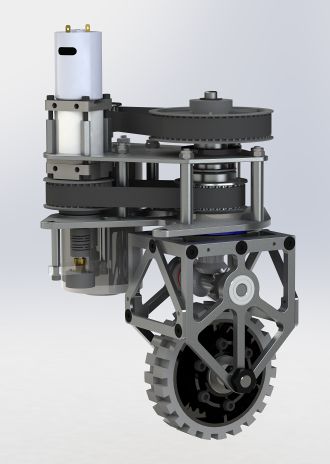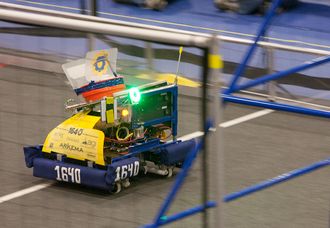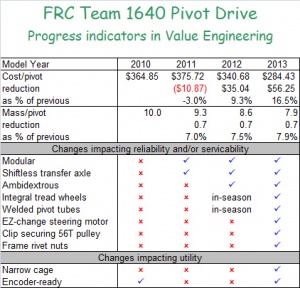DEWBOT IX Drive Train
Contents
Issues with the 2012 pivot design
Our 2012 robot, DEWBOT VIII, participated in more competitions, demos and driver practice than any robot before it. In addition, barrier crossing (which we did often) was abusive to pivots and the robot in general. That said, the 2012 pivots generally performed very well, but the following issues were observed:
- Pivot tubes were not secure within the pivot tops and shifted over time. Small and mostly angular shifts resulted in loss of calibration. Large shifts caused pivot failure. This problem was resolved during the season by welding the pivot tubes to tops.
- The BaneBots RS-540 motors used in 2011 were not legal in 2012, so RS-395 motors were used instead. These motors are sufficiently powerful, but have very weak and easily damaged mounting points. The gearbox mounting plates for these motors also cover the front cooling ports, leading to easy burn-out. We literally ‘’burned’’ through a lot of RS-395’s in 2012.
- Steering motor replacement required a significant disassembly of the pivot module. This was annoying in 2011 with the RS-540 motors, but became a real problem in 2012 with the 395’s requirement of frequent replacement.
- Pivot module bottom plates tended to bend in service. The 5th bolt hole for securing this to the robot chassis was almost never used.
- Set screws securing the 18T and 56T HTD5 pulleys to the CIM and coaxial drive shaft, respectively, did not reliably secure these pulleys. This never resulted in a loss of drive power, but was troubling.
Value Engineering
Value engineering seeks to widen the gap between the value a product provides to the customer and its cost. Value and cost in this context includes both monetary and non-monetary measures. For example, addressing the issues listed above increases the value of the product to the customer (drive team & pit crew). Cost includes monetary cost (measured following FRC cost guidelines) but also mass, manpower and machine time.Each Autumn, we conduct a value engineering exercise on our pivot drive design to understand what changes we would make if we were to select pivot drive again. The results of this exercise are summarized in the accompanying Table.
Developments on the 2012 pivot design
Development of the 2013 pivot design took place through a number of physical tests and engineering exercises during the latter half of 2012.
The following design changes were made:
- Switched back to BaneBots RS-540 motor (legal again) in lieu of RS-395
- Replacing 35 chain with 25 chain - 9T & 24T sprockets replaced with 12T & 32T - 44 link 25 chain reduces pivot cage height
- Change wheel to AndyMark 4" HiGrip Wheel (am-2256) - 32T sprocket secured w/ 10-32 x 5/8" SHCSs - No sprocket spacers needed
- Adopted the VexPro 32T sprocket
- Replace top 1" ball bearing race with Igus bushing
- Narrow pivot cage from 4" to 3.184" - machined acetal spacer eliminated - shorter axles
- Pivot tube designed to be welded into the pivot top
- Drive miter gear shortened axially by 0.25" - further reducing pivot cage height
- Elimination of (1) of (2) E-clips on the pivot tube
- Reduce spacer length between module plates to 1.75" (2" in 2011; 1.875" in 2012)
- Use Deaver steering motor attachment
- E-clip securing the 56T HTD5 pulley
- Reduce pivot mount points from (5) to (4) and replace locknuts with rivet nuts on frame
- 7075 Al replaced 6061 in the pivot braces and the module top plate
- Redesigned module bottom plate to provide additional strength (and look cooler)
Ocelot Drive
The most exciting change in the 2013 drive-train had nothing to do with the pivot mechanism, but rather with the software controlling it.When we first developed pivot drive, we understood that it offered the potential for dynamic driving in addition to straight-forward crab & snake drives. Up until now, however, we have not been able to realize this potential and have managed with static drive modes (where joystick position maps directly to wheel positions).
Senior programmer Dhananjay (DJ), with help from mentor Gary Deaver, wrote the LabView vi for Ocelot drive. Programming Lead Mike M integrated the code and streamlined the wheel positioning to be resource practical on the cRIO.
A great job.


